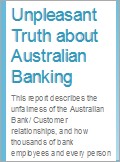The banks have been part of Australian society for more than a century however the government did not formally nationalise them until 1947. Since then, the government has attempted to establish a competitive banking and finance sector that is best for the industry and customers.
The Australian public needs to put its trust in the banks. Since deregulation in the 1980s, the ABA and its directors, the bank CEOs, have effectively been managing the banking industry.
The key ABA officers from 1997 were: Frank Cicutto, NAB, Chairman, Ed O’Neal, St George Bank, Deputy Chair and Jeff Oughton, Chief Executive.
Changing The Guard (2001-2003)
In 2001 – ABA undergoing culture change.
David Bell was appointed CEO.
David Murray, Commonwealth Bank, was elected Chairman, and
Ed O’Neal is re-elected Deputy Chairman.
In 2002/03 – ABA changing of the guard.
John McFarlene, ANZ Bank, replaced David Murray as Chairman.
Gail Kelly, St George Bank replaced O’Neal as Deputy Chair, and
David Bell continues in his role as CEO.
The ABA Member Banks (2002)
Adelaide Bank
AMP Bank
Arab Bank Australia
ANZ Bank Limited
Bank of Cyprus Australia
Bank of Western Australia
Bank of Queensland
Bendigo Bank
BNP Paribas
Citibank Limited
Commonwealth Bank of Australia
Credit Suisse First Boston
HSBC Bank
Mizuho Corporate Bank Limited
Laiki Bank (Australia)
Macquarie Bank Limited
National Australia Bank
NM Rothschild and Sons (Aust) Limited
Primary Industry Bank of Australia
St George Bank
Suncorp Metway Bank Limited
United Overseas Bank Limited
Westpac Banking Corporation
Richard Viney’s Code Review (2000-2003)
The Richard Viney Code review was carried out during the ABA changing of the guard. In 2000, Richard Viney heard the first set of submissions to the ABA review from consumer groups and government bodies.
In general, the submissions raised concerns regarding the lack of transparency in compliance monitoring. However ASIC stood aloof while the banks got on with their business. It was agreed there needed to be an external and independent monitoring body overseeing the banks compliance.
What Bank Customers Wanted
Issues raised in submissions, included:
Joint Consumer Organisations: requested compliance monitoring, complaints handling mechanisms, enforcement of sanctions against institutions breaching the Code, public reporting of Code compliance and powers to remove subscribers from the Code.
Australian Consumers Association: asked for pre-contract disclosure to all consumers with improved disclosure on fees and charges, clear guidelines for account closure and default, accuracy in advertising and accessible standards for internal dispute resolution.
Consumer and Business Affairs Victoria: called for greater transparency and accountability in compliance monitoring and sanctions for subscribers who breach the Code.
National Farmers Federation: asked banks adopting the Code that their members not be excluded from certain sections of it. An end to unilateral imposition of fees and charges was also called for, along with more direct communication of changes in rates and fees.
Standards Australia Committee: noted if an agency has a visible, accessible and responsive complaints handling system, consumers are less likely to turn to the ombudsman’s office.
As an issue of fairness, complaints procedures need to be available to the public and they should be given reasons for any decision not to uphold their complaint, and informed about appeal rights and further review.
ASIC: called for external monitoring, provisions on sanctions and publicity of breaches, regular Code review and disclosure on fees and charges.
ACCC: supported ASIC’s views and made the point that although policy underpinning the Trade Practices Act is the promotion of competition, it is not competition at any cost to society.
What the ABA and Banks wanted
Commonwealth Bank: believed there was a need for regular and transparent reviews of the Code, involving a wide process of consultation with community, consumer and government bodies.
National Australia Bank: said the Code must be independently monitored and reviewed every three years, using a transparent process with submissions from community.
Westpac and NAB: voiced concerns there were parts of the Code that duplicated legislation in the Privacy Act, Financial Services Reform Bill, Electronic Funds Transfer Code and Uniform Consumer Credit Code. Without good reasons, they believed the revised Code should not duplicate other regulation.
The Bankers Association: suggested the definition of a banking service be any financial service provided by a bank to a customer. They recommended establishment of a Code Compliance Monitoring Committee, however it should only be given a naming sanction for repeat offenders.
Senate Committee Report webpage (Sub No. 90): Click Here…
